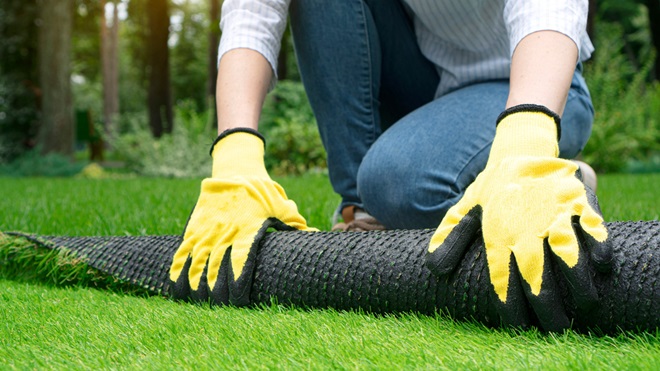Whether you're worried about the impact your artificial lawn is having on your home's ecosystem, or you're just sick of dealing with some of the downsides of fake grass, swapping your plastic lawn for the real deal is definitely something you can do yourself.
If you're thinking of making the switch back to natural grass, you might be wondering how difficult it is to remove artificial turf, and what steps you need to take to get the soil ready for real grass. We asked MyHomeTurf services manager Nathan Tovey to talk us through the process.
Removing the artificial turf
- Grab some gloves and a mask. Removing artificial turf (especially if it's old and poorly maintained) can be dirty work.
- Cut your turf into more manageable pieces. Bear in mind it's very heavy.
- Remove any pegs or stakes securing the turf.
- Start ripping up the turf with your hands.
- Continue until all turf is removed and dispose of the turf responsibly.
Installing a natural lawn

You'll need to rejuvenate the soil before installing fresh turf. (Image: MyHomeTurf )
If you want to replace your artificial lawn with the real deal, Tovey says you'll need to rejuvenate the soil health. "The soil will be dry, dusty, compacted and stale. It's not healthy soil – it has had limited oxygen," he says.
- Use your shovel to remove the base layer of crushed rocks.
- Test the pH of the existing soil using a test kit that you can buy from a garden centre. A good pH is 6.5–7. Tovey says the soil under artificial turf is often acidic (a pH under 6.5). If this is the case, he suggests buying some lime to increase the pH.
- Decompact the soil either by using a garden hoe (for smaller areas) or a rotary hoe (for larger areas).
- Once the soil is broken up, you can add in your lime if necessary, plus some organic matter (e.g. Dynamic Lifter/ Rooster Booster). You may also need to add gypsum if it's a heavy or clay soil.
- Next, you'll need to replace the volume lost by removing the base layer to bring the level of the lawn up. To do this, you can buy lawn mix or turf underlay from your local garden centre and spread it across the lawn.
- You'll then need to level off the topsoil and compact it slightly, which can be done by simply walking back and forth over the lawn.
- Apply lawn starter fertiliser.
- Lay the new turf in a brickwork formation.
- Water, water and water until the area is squelching underfoot. The water needs to penetrate the top of the turf and reach the soil underneath.
Can artificial turf be recycled?
If you're planning to remove your artificial turf, you may be looking for the most environmentally friendly way to dispose of it. Unfortunately, there aren't a lot of good options available currently.
You may get advice to donate your old turf to be reused by animal shelters, playgrounds, cricket batting cages and dog parks. We haven't found clear guidance on how to arrange something like this, or any strong evidence that organisations would want to use old artificial turf. But it's certainly worth asking around your local community, especially if your lawn is still in good condition.
It's worth noting that cutting your turf up to be reused by others may mean it can't be processed by a recycling plant in the future, so it will ultimately end up in landfill. Not all turf types are recyclable either, so you might like to look into this before you decide what you want to do with your old turf.

Cutting your turf up to be reused by others may mean it can't be processed by a recycling plant in the future. (Image: MyHomeTurf )
Australia's first synthetic turf recycling facility Re4orm was established this year in Victoria, by synthetic turf provider TUFF Group. They currently offer a service removing synthetic turf from sporting fields, clubs, educational facilities, childcare centres and community organisations, and director Trent Cummings says that they're keen to process residential lawns too.
"Currently, because of economies of scale, we can't go to residential homes and collect small amounts of turf for processing," he says.
The number of homes with artificial lawns is growing, and valuable resources are being wasted when these lawns enter landfill instead of being recycled
Re4orm director Trent Cummings
"What we're hoping to achieve instead in coming years, is to work with local municipalities to implement disposal bins in transfer stations where people can take their artificial turf.
"These bins already exist for e-waste and paint. The number of homes with artificial lawns is growing, and valuable resources are being wasted when these lawns enter landfill instead of being recycled."
While the specialised bins are the vision for the future, there isn't currently any infrastructure set up for recycling residential turf. However, Cummings says Melbourne residents can contact Re4orm to discuss dropping off their synthetic turf subject to certain acceptance specifications and applicable fees.
We're on your side
For more than 60 years, we've been making a difference for Australian consumers. In that time, we've never taken ads or sponsorship.
Instead we're funded by members who value expert reviews and independent product testing.
With no self-interest behind our advice, you don't just buy smarter, you get the answers that you need.
You know without hesitation what's safe for you and your family. And our recent sunscreens test showed just how important it is to keep business claims in check.
So you'll never be alone when something goes wrong or a business treats you unfairly.
Learn more about CHOICE membership today
Stock images: Getty, unless otherwise stated.



